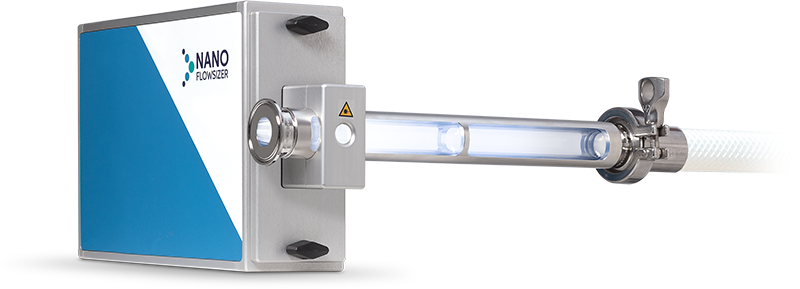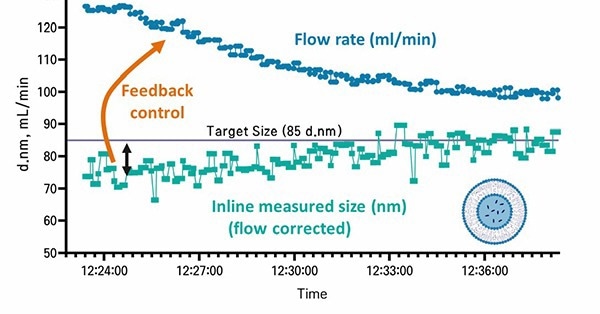Antonio Costa, Ph.D., DIANT Pharma Inc. & Frando van der Pas, InProcess-LSP
Nanoparticles have once again reached the spotlight, this time as a critical tool to combat the spread of covid-19. In this particular case, messenger ribonucleic acid (mRNA) encapsulated in lipid nanoparticles (LNPs) have been successfully manufactured, distributed and administered to populations throughout the world.
The high efficacy and strong protection of the covid-19, mRNA-LNP vaccines have made them an ideal candidate for future vaccines and therapeutics. However, information released by the EMA covid-19 data leak emphasizes the need to better understand quality issues observed throughout the LNP manufacturing process. As an example, quality issues may be traced to RNA instability and LNP particle size. In this article, process analytical technology and continuous processing of nanoparticles will be introduced as a means to provide the necessary quality required for these injectable, complex formulations.
mRNA-LNPs
mRNA-LNPs can be divided into four main component types, namely: (1) an ionizable, cationic lipid; (2) one or more neutral/structural lipids; (3) mRNA and (4) buffering system(s) and water. All of these components come together to form a sophisticated and tunable delivery vehicle. In this case, the delivery cargo is mRNA and the target delivery location is a specific tissue or cell type.
There is a truly remarkable relationship between all of these components that make LNPs a success story. To start, the mRNA, which has a particular sequence of nucleotides, is processed by ribosomes to synthesize a protein (e.g., the Spike protein). The ionizable, cationic lipid has multiple roles such as promoting the encapsulation of mRNA during the LNP synthesis process and also for endosomal escape; releasing the mRNA into the cytosol. The neutral/structure lipids, such as DSPC and cholesterol provide the general framework or structure of the particles, whereas pegylated lipids coat the surface of the LNPs and provide physical stability as well as enabling longer circulation times in the host. Buffering systems are important for properly forming the particles, i.e., in an ionizable state, and for neutralizing the particles.
Water is also highly important in the core structure of the LNP by providing a continuum of hydrogen bonds between the mRNA and the hydrophilic portions of the lipid components. Accordingly, the LNP formulation is a critical factor linked directly to RNA encapsulation and multiple aspects of pharmacokinetics/pharmacodynamics (e.g., localized target tissue/cellular expression).
Liposomes
Liposomal nanoparticles have been approved as drug products throughout the world for a variety of clinical indications including cancers and fungal treatment, with the highest percentage of liposomal drug products as anti-cancer therapies. The active pharmaceutical ingredient (API) in these drug products are typically small molecules such as doxorubicin, daunorubicin, cytarabine and irinotecan. A major benefit of liposomal drug products is that they greatly reduce side effects that occur with non-liposomal chemotherapy treatments. In addition, liposomes promote longer blood circulation times, resulting in a longer half-life of the API. The basic principle of how liposomes are effective is that they deliver a high payload directly to the site of action (e.g., tumor site), resulting in a more efficacious and safer drug product. Although these therapeutics are very beneficial to patients, manufacturing and scalable processing technology platforms are still being developed.
In brief, liposomes consist of a lipid bilayer that surrounds an aqueous compartment. The majority of liposomes that have been approved by regulatory agencies have lipid compositions that include phosphatidylcholine lipids, cholesterol and either a pegylated- or charged-lipid. The composition of the lipid bilayer plays a major role in particle stability, both in storage conditions and in-vivo; therefore, the type of lipids and molar ratios of such are considered critical material attributes. For example, cholesterol is known to affect bilayer rigidity and pegylated lipids promote steric stabilization of the bilayer. The active pharmaceutical ingredient can either go into the lipid bilayer or it is encapsulated in the aqueous compartment. Moreover, targeting moieties can be added to the lipid-bilayer to provide a direct targeting mechanism in-vivo.
Current Manufacturing Methods
Current manufacturing methods to produce lipid-based nanoparticles include solvent injection, homogenization and microfluidic mixing. Solvent injection methods are typically performed by premixing ethanol with lipid and then injecting such mixture into an aqueous phase. Solvent injection methods comprise crossflow injection, static-mixers, microfluidic-mixing and turbulent jet technologies, with the latter providing a highly controllable mixing strategy.
Microfluidics offers a variety of mixing techniques and various geometries have been developed to mix the solvent stream with the aqueous stream. Each of the above strategies relies on different degrees of convective and diffusive forces for mixing. For example, microfluidics may mix in a very low Reynolds number state (i.e., laminar flow), whereas crossflow injection, t-mixers and turbulent jets operate at much higher Reynolds number states (i.e., turbulent flow).

Figure 1. DIANT LF system for nanoparticle synthesis, part of the DIANT production series. Image Credit: InProcess-LSP
Continuous Processing of Nanoparticles
DIANT Pharma introduced a series of systems that use continuous manufacturing technology implementing a turbulent jet in co-flow. Integrated process analytical technology provides enhanced control from particle formation throughout downstream processing. Downstream processing includes UF/DF, purification and bioburden reduction.
The system is scalable, turnkey solution that uses only a single jet, producing particles from 0.2 LPM up to 100 LPM (Figure 1). The scalability of this technology is an important consideration when selecting processing equipment from lab to commercial scales. The DIANT system has multiple modules and is offered as a continuous, closed system.
The add-on modules include a buffer exchanger/concentrating module, an active loading/surface modification module, and a final purification stage and bioburden reduction module. The system can be a hybrid system, i.e., run in single unit operation/ batch mode, or as an integrated system in an end-to-end continuous manufacturing process.

Figure 2. NanoFlowSizer, an important process analytical technology (PAT) tool used to provide online particle size data. Image Credit: InProcess-LSP
Process Analytical Technology: DLS for Automatic Particle Size Control
One of the PAT tools integrated within the DIANT systems is the NanoFlowSizer (Figure 2), a spatially-resolved dynamic light scattering technology developed by InProcess-LSP. This PAT tool is highly useful in measuring multiple attributes of the particles, such as the Z-average (d.nm) particle size, polydispersity index (PDI), turbidity and PSD distributions. Attributes such as the Z-Average particle size and PDI are typically listed in product specifications and are considered critical quality attributes for liposomes and LNPs.
Spatially-resolved dynamic light scattering was incorporated over other DLS techniques as it enables particle size analysis at high flow rates, such that the particle size can be analyzed online and/or inline, as opposed to at-line or offline analyses.
The online/inline approach supports a rapid assessment of the particle size and directly measures the particles in the process stream without the nanoparticles going to waste or requiring sample handling by an operator. There is also the major benefit in that the NFS flow cells can be cleaned-in-place or steamed-in-place.

Figure 3. Example particle size data for a 30-minute run. Image Credit: InProcess-LSP
Enhanced Control Using the DIANT System
By measuring the particle size online or inline, the particle size measurements can be used as a feedback mechanism to control the formation of the nanoparticles. When considering that nanoparticle formation is highly susceptible to process condition changes, the added layer of protection by using a feedback mechanism will provide the much-needed quality control. Long duration runs while experiencing subtle changes in the local environment can impact the overall process on the nano-level. Thus, having the NanoFlowSizer and feedback algorithms in the DIANT system provides a highly reproducible and consistent particle size from the beginning to the end of the run (Figure 3).
Research and Development System: A Low Flow Starting Point
The DIANT LARU is a lower flow, continuous processing system using the same jet technology found in the DIANT production series. (Figure 4) This system is designed to have a low dead-volume to reduce material costs such as when working with costly lipid or mRNA. The DIANT LARU is offered with multiple add-ons, such as an inline particle size module and a tangential flow filtration module.
Conclusion
Lipid-based nanoparticles have a bright future in both the vaccine and therapeutic space. Scalable, high-throughput processing technology is required to move smoothly from lab to commercial scales. The DIANT systems integrated with the NanoFlowSizer provide the enhanced control required to consistently produce uniform and high-quality nanoparticles.

Figure 4. DIANT LARU, a research and development system for nanoparticle synthesis, scalable to the DIANT production series. Image Credit: InProcess-LSP
About the Companies

DIANT Pharma was founded in 2019. DIANT’s proprietary continuous manufacturing technology for nanoparticles has a wide array of applications throughout multiple industries. The DIANT series systems use state-of-the-art nanoparticle processing technology, including a scalable jet that makes the generation of nanoparticles simple from R&D to production. DIANT Pharma is always looking for partners to broaden the use of its technology. www.diantpharma.com
InProcess-LSP is an entrepreneurial organization providing advanced analytical services and solutions to support product and process challenges. With a strong background in Process Analytical Technology and many years of academic and industrial experience, they offer a highly skilled and experienced team of scientists and process specialists. InProcess-LSP first commercialized its unique NanoFlowSizer technology in 2019. www.inprocess-lsp.com

This information has been sourced, reviewed and adapted from materials provided by InProcess-LSP.
For more information on this source, please visit InProcess-LSP.